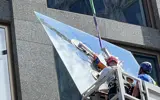The Top 5 Signs Your Façade Needs Attention (Before It’s Too Late)
Your building’s façade does more than just create a first impression. It protects the structure from the elements, helps regulate indoor temperatures, and plays a key role in safety and comfort. Over time, even the most robust façades can develop issues that, if left unchecked, may lead to serious problems. Regular inspections and maintenance are essential, and spotting the early signs can save significant time, money and disruption later on.
Here are the top five signs that your façade could be in need of attention, covering both visible and less obvious indicators.
1. Condensation Between Glass Panels
This is one of the clearest signs that something isn’t right. If you notice fog, misting or moisture trapped inside your double- or triple-glazed units, it often points to a failed seal. This means the insulation performance of that unit has been compromised. While it may start off as a visual annoyance, over time, a failed seal can lead to a reduction in energy efficiency and allow moisture to reach other parts of the façade, potentially causing internal damage or deterioration of surrounding materials.
2. Cracks in the Glass or Framing System
Cracks, chips or fractures in glass panels can sometimes be small enough to miss at first glance, but they should never be ignored. Glass that has been impacted, exposed to thermal stress or weakened by structural movement can become dangerous if left untreated. Similarly, cracks in the framing system can indicate movement, stress or material fatigue. These can compromise the structural integrity of the façade and allow water or air to enter where it shouldn't.
3. Gaps or Deterioration in the Sealant
Sealant is often overlooked, yet it plays a vital role in keeping your façade weather-tight. Over time, sealant can shrink, crack or peel away from the surfaces it was meant to protect. This can lead to air leaks, water ingress and reduced thermal performance. It’s important to check for missing or brittle sections of sealant around glazing units, panel joints and where different materials meet. Inconsistent temperatures and UV exposure tend to accelerate sealant breakdown, making this an area that requires regular inspection.
4. Doors that Stick or Misalign
Doors that are difficult to open or close smoothly can be more than just a nuisance. Misaligned doors may indicate that the frame has shifted, warped or suffered from wear and tear over time. This can lead to gaps around the door, poor sealing, and issues with locking mechanisms. If your façade includes integrated door systems, these should open and close effortlessly. Any resistance or uneven movement could be a sign of deeper problems within the façade’s structure.
5. Staining, Discolouration or Damp Inside the Building
Not all façade issues present themselves on the outside. Sometimes the first signs of trouble appear indoors. Damp patches, peeling paint or unexplained stains on interior walls close to windows or doors can be signs of water ingress. This is especially common in façades with hidden leaks, where water has found a way in through a compromised joint, failed seal or damaged panel. These issues can go unnoticed for long periods, causing gradual damage to internal finishes, insulation and even the building’s structure if not addressed.
Spotting and acting on these signs early is critical. The longer façade issues are left unattended, the more expensive and disruptive the eventual repairs are likely to be. Whether you’re managing a commercial building, residential block or high-traffic public space, keeping your façade in good condition is a smart investment in safety, performance and appearance. If any of these signs sound familiar, it might be worth speaking to a specialist for an expert opinion before minor issues turn into major ones.
GLASS AFTERCARE ARE TRUSTED BY










